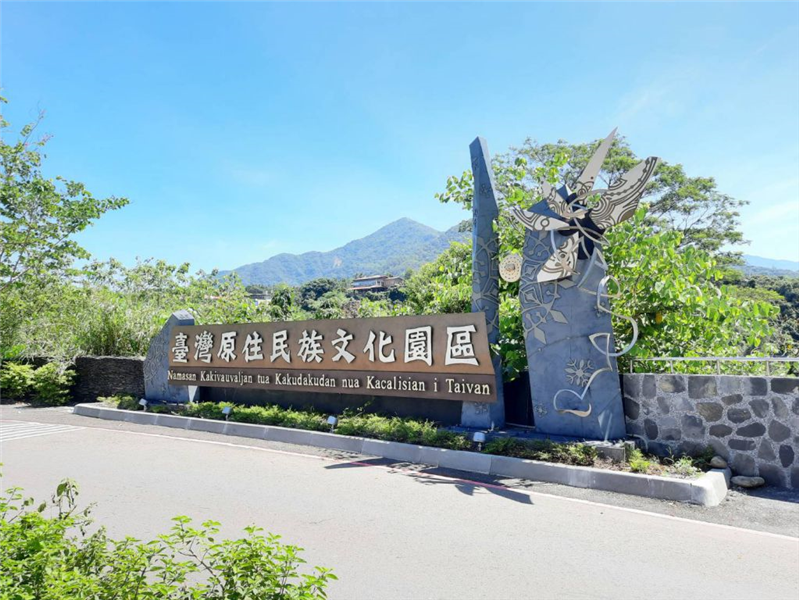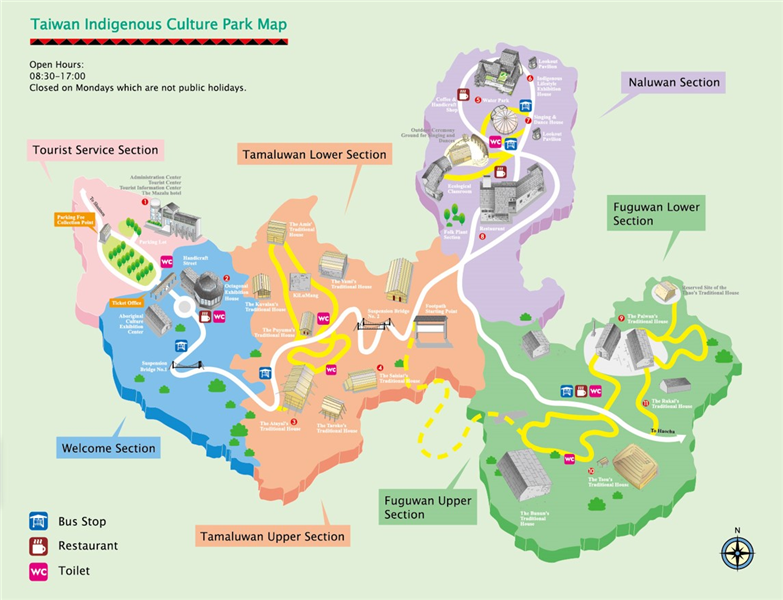
The Taiwan Indigenous Culture Park, located in Pingtung County in southern Taiwan, is 24 kilometers away from Pingtung City, and it takes ten minutes’ drive from the Changzhi off –ramp on Formosa Freeway. The Park lies across the Ailiao River between Majia Township and Sandimen Township. The large and spacious park is located in a mountainous area of 145 to 220 meters above sea level, and therefore the natural scenery here is beautiful and diverse.


 Open Hours:
Open Hours:
8:30-17:00
Closed on Mondays
Open on public holidays
104 Fengching,Peiyeh Village,Majia Township, Pingtung County90341 Taiwan (R.O.C.)
The Indigenous Culture Park was opened to the public in 1987. It was established as an outdoor museum in the Fuguwan region, which in the Paiwan language means "fertile land". It is located near the Ailiao River at the foot of Dawu Mountain, in Beiye Village of Majia Townshipin Pingtung County, and is at the border of Majia Township and Sandimen Township. To enter thepark, it is necessary to pass Shueimen, which is the transportation hub for the three indigenous villages of Sandimen, Majia, and Wutai. Living nearby are the Paiwan and Rukai tribes, and so the area is immersed with indigenous cultures. The park has a total area of 82.65 hectares, at an elevation of between 145 and 220 meters. The park is rich in natural beauty with diverse landscapes. It is divided into four sections:
This section includes the Special Exhibition Room, Artifact Display Room, Audiovisual Room, Handicrafts Room and Octagonal Special Display Hall to provide an overview of Taiwan's colorful cultural diversity of the twelve officially recognized tribes. The exhibits in the Artifact Display Room are mostly the daily necessities and working tools once used by Taiwan's indigenous tribes. They are the testament to the intelligent application of their knowledge of nature to their daily lives. Next door to the Artifact Display Room is the Audiovisual Room, which provides film introduction about the past, present and future of Taiwan's indigenous tribes.
The first building appearing in your eyes is the Tourist Service Center upon entering the compound of the Taiwan Indigenous Cultural Park. Naming after an Amis term “Makalafang”, it carries the meaning of both a tourist attraction and welcome. It is designed to be a cultural supply station, offering facilities such as the Administration Center, Villages Cultural creation and Aesthetic Concepts Gallery and a Hostel. Right from the entrance to the parking lot, visitors feel very differently from other ordinary public facilities, especially when they enter its lobby and see a giant installation art piece of contemporary indigenous peoples’ culture.
The Tourist Service Center is filled with the exotic art styles of indigenous peoples, hence a cosy and recharging venue. It contains a café, food bar, bookshop and cultural creation art pieces, among others, which make it the best place to rest your fatigued legs for a moment.
Alternatively, sipping coffee or reading a book in the shade of the aged camphor trees offers one an extraordinary experience of tranquility and relaxation amidst woods in the mountain. In addition to the quality rooms and service, the Hostel overlooks villages with spotted dimming lights from afar under the starry dome at night, while enjoying the concerto of nocturnal insects in solitude! It is worth staying overnight at the Indigenous Cultural Center to personally experience the real and multi-cultural facets.
Papakufang District
Following the viewing route of Bougainvillaea, you will firstly arrive at the guiding station from where you start a journey to discovering an exotic culture. Also named after an Amis “Papakufang”, it denoted a place for collection of art pieces and relics.The greeting and salutation area where bamboo cannons are fired one after another at regular intervals to welcome distinguished visitors with the companion of passionate indigenous songs and dances.
An Indigenous Cultural Museum here displays relics and items of indigenous peoples’ daily life, depicting the wisdom and adaptivity of indigenous peoples. The Audio-Visual Room shows films of the Park and the life and culture of the indigenous Peoples in the past, at present and in the future. The Art Craft Street exhibits exquisite artworks by the indigenous peoples and hence it is an essential window to showcase Taiwan indigenous artists’ art pieces.
Tamaluwan District
Leaving Pakakufang District and crossing the first Rainbow Suspension Bridge, one enters the district for exploring the traditional housing area of the indigenous peoples. Named after a Bunun term “Tamaluwan”, meaning tribal family house. The entire District demonstrates traditional architectural aesthetic beauty of artisanship of different indigenous peoples. At the bus stop visitors can opt to take tour trolley toexcurse the Park, or take a stroll along the winding routes to visit every spot of interest as an enjoyable venue for outdoor activities.
The upper part of the Tamaluwan District contains the traditional houses of Seediq, Atayal,Truku and Saisiyat, while the lower part accommodatesthe embodiments of those of Puyuma, Amis,Kavalan, Sakizaya and Thao.In order to impress the visitors with down-to-earth indigenous culture, various activities are designed in this District to experience the Atayal facial tattoo, hip bells of Saisiyat, xylophoneand swing of Pymuma, children’s toys, traditional costumes and experiencing activities of indigenous peoples.
Naluwan District
The tour trolley ascends along the route and passed the flying fish iron sculpture, on the right side ofthe ………… Pavilion (查卡麓亭) one’s eyesight will be attracted by the giant colorful wooden sculpture of indigenous style. This is one of the best spots for taking photos for lifetime memory. It is a rejoicing moment after having viewed various static exhibitions and houses all the way here.
This District is named after a function word in Amis singing “Naluwan” denoting it is a place to rejoice. Simply because there is a performing theater specifically designed for the Naluwan Music and Dancing Group to perform programs of individual indigenous people, including brilliant costumes and accessories together with multi-faceted and colorful music and dancing culture. Spectators will have opportunities to join the performers on the stage in the joyous and energetic atmosphere. In the backside of the theater is the Lifestyle Exhibition Hall, where a tunnel of time showcases rituals and actual lifestyle of the indigenous peoples in Taiwan.
The Naluwan performing Theater dome was built in 1996, occupying a land area of about 2,200 square meters, to accommodate 2,000 people. Visitors who take trolley to arrive at the entrance of the Theater will be greeted by a giant wooden carving on the doors with indigenous totem, allowing a mysterious and indigenous feeling around. The indoor performing Theater keeps off grilling sunshine and is a must for every visitor to enjoy elegant dances and musical euphony of indigenous peoples.
Fuguwan District
Chakalu Pavilion is the demarcation of Naluwan District to the left and Fuguwan District to the right in a matter of a couple of minutes by car.Itis named after a Paiwan term “Pukubavan” for a barn,also a harvest. The upper part of Fuguuwan District contains traditional house of Tsou,Bunun,Hla’alua and Kanakanavu,overlooking Ailiao River and Sandimen Village; while the lower part exhibits those houses of Paiwan , Rukai and thao,partly of which display beads and beading techniques,wood carving skills and art works.
It is indeed worth viewing. Artists-in-residence are based here as the starting point of their creation and articulation,with an aim to practically explore unlimited possibilities of indigenous art,culture,the spirit and process of joint creation.